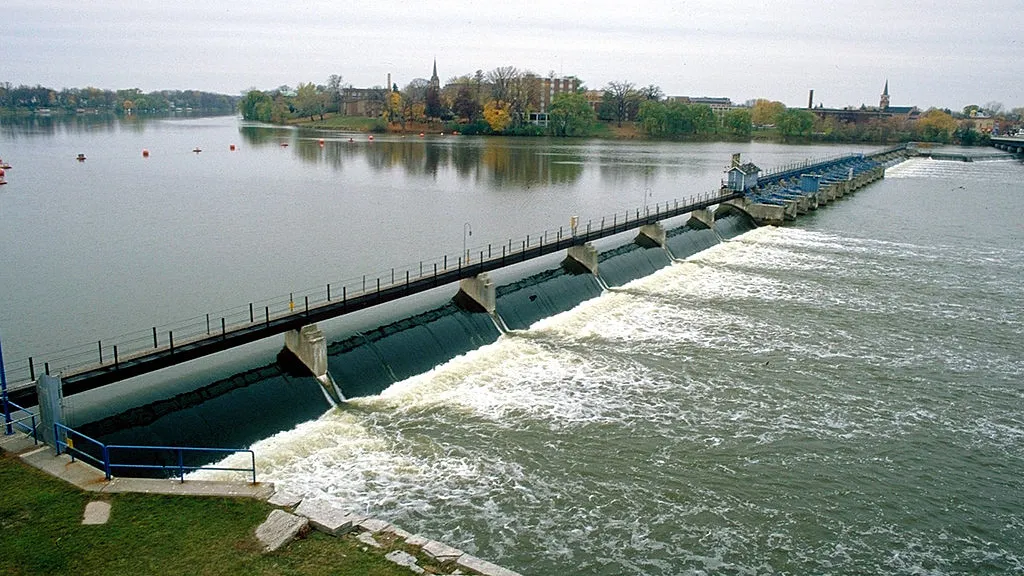It is hard to believe that it’s already mid-July and we are all wrapping up our time in the EC program! I feel like this summer has flown by. A lot has happened since my last blog post! We’ve had two rounds of focus group meetings, I presented to the Water Quality Policy Management Team, visited the WDNR Green Bay and Oshkosh offices, helped create a flow chart on how fish passage policy will be communicated for dams, and went to a Madison Mallards game with fellow DNR staff.
When I last wrote I was prepping for our first round of focus group meetings. Since then we’ve had two rounds of meetings for each of our two groups, Water Quality (WQ) and Aquatic Invasive Species (AIS). Our first round of meetings went well and helped us to understand staff’s initial thoughts about monitoring at Federal Energy Regulatory Commission (FERC) dams and their level of knowledge about how the FERC process works, along with what they think about the current level of monitoring at FERC dams.
When planning our focus groups, we prepare questions with the hope to gain some sort of knowledge or consensus from the group about a specific topic. Deciding on and phrasing these questions can be harder than anticipated with questions evolving multiple times. Dams are unique and often complex; I’m learning that questions I thought would be easy to answer like – “what does the DNR call the water behind a dam?” are not always straightforward… The water behind the dam can be called a reservoir or an impoundment or an impounded flowing water. Now you might be thinking, aren’t those all the same thing? Not quite, they could have slightly different definitions depending who you ask and/or what you’re wanting to know. This is just one example of how questions we propose to the focus groups need to be worded to fit who we’re asking and/or what we’re trying to answer.
Last week we had our second round of focus group meetings. For these meetings I took on more of a leadership role by not only taking the lead on creating the PowerPoint, agenda, and other supplemental materials but also by helping to facilitate the meetings. I was pretty nervous about facilitating and was a big ball of anxiety the night before the first of two meetings. However, after the first meeting, the second one the next day was much less stressful. I had kind of an aha moment and thought, “I need to stop and reflect on the tools we were given and what we learned about running effective meetings in the EC program.” I thought about what we learned about facilitation at the Aldo Leopold Leadership Training and lessons I’d learned from running an online meeting in Rob’s class second semester. (Note: most meetings at the DNR consist of some staff attending in person along with field staff/others attending remotely via skype.) I also thought back to my job at the law school and running the weekly meetings for study group leaders… how it took time for me to feel confident and comfortable in my role but once I did, the meetings were much easier to facilitate. Facilitation can be awkward but I think as I get to know the participating staff better and become more confident in my knowledge of the subject it will get easier. I also want to give a shout-out to my supervisors because they helped keep conversation flowing during the meetings, especially when I didn’t have enough subject knowledge to ask the deeper questions.
I also had the opportunity last week to present at the Water Quality Policy Management Team’s monthly meeting. I mentioned this group in my previous blog, they consist of the section chiefs within the water quality bureau and make decisions regarding policies, guidance, and other controversial issues. Like the focus groups, this meeting consisted of some staff attending in person while others attended online via Skype. It was a good learning experience presenting to leadership a summary about what we’ve been accomplishing and what we may need their guidance/approval on in the future.
Another thing I’ve been helping with and learning about is the Fish Passage Policy Team’s communication plan. This is going to be used when an organization/group proposes a fish passage for a dam in Wisconsin. I’ve been helping them create a flow chart that shows how the department’s internal communication will proceed when a request is received and how external opinions play into it. It’s interesting attending these meetings and learning from DNR leadership and other staff how internal communication works at such a large government agency. Because of my involvement with this group, I got to travel to the Green Bay office for a meeting and on the way, we stopped at the Oshkosh office. It’s always fun to visit other DNR offices and get a sense for the vibe at each location. I also got to talk with a couple staff and learn about what they do, how they got to where they are, and talk with them about my interests.
An “extra” thing I got to do recently is attend a Madison Mallards baseball game with DNR staff from the Water Quality Bureau! It was fun to talk with people outside of work in a more casual setting as well as meet staff I hadn’t met yet. It reminded me of the importance of getting to know about co-workers’ personal lives rather than just knowing about their work-life. In my last couple of jobs, I’ve been fortunate to have supervisors that encourage out of work gatherings among staff, and I’m learning that many DNR supervisors have similar thoughts.
One last bit of news, I’m happy to say I was offered a full-time, Limited Term Employment (LTE) position to continue my FERC process improvement work for 6 more months… so it looks like I’ll get to stay in Madison a little bit longer
